I’ve always been interested in the idea of liminal spaces, that strange place which exists, or non-exists, between other things. It’s a concept I explore a great deal in my poetry. It could be the moment between sleeping and waking. It could be a whole film. Brief Encounter appears to be mostly set in a liminal space. Laura (Celia Johnson) and Alec (Trevor Howard) meet on a train station and much of the action takes place here, particularly in the waiting room – a classic liminal space. Their love-affair is doomed from the start – a brief passionate interlude, unrealised and unconsummated as both protagonists are drawn back to their sober, dutiful lives. There are angsty, canted angles when Laura is in danger of going too far (there’s a very film noir kiss in an underpass, shadowy and sinister) or when her state of mind is unbalanced almost to the point of suicide. The film has been called the “Anna Karenina of the home counties” with one critic scathingly saying “make tea, not love”. Audiences at the time were famously irritated with Alec and Laura’s inability to “get a room”! If you ever get the chance to visit the Carnforth Station in Lancashire, where the film was shot, you are in for a treat. It houses an excellent heritage centre with, at its heart, a celebration of David Lean’s 1945 classic. You can even have tea in the faithfully restored Refreshment Room which sports huge, rather intimidating tea urns.

My favourite liminal space, however, is the pier. It’s not sea, it’s not land. As soon as you step onto a pier life feels full of possibilities and difference. Southwold Pier is surely the most unusual you’ll ever encounter.

I last visited in December when Southwold beach was shrouded for hours in a thick sea fret and the pier only came into view as we were almost at the steps. As well as great shops and cafes, the pier is home to Tim Hunkin’s “Under the Pier Show”, a superb collection of unique, hand-built, wacky machines (there’s also an amazing clock halfway down the pier which comes to life on the hour). In the “Mobility Masterclass” you have to get gran across a busy road with her zimmer frame. There’s also the deeply satisfying “Whack the Banker”. The most recent addition is “airbednbug” where a few coins activate a sort of live storyboard about persecuted bedbugs – it’s charming – a comic strip come to life. My favourite moment is when the bedbugs realise they have to move and are leafing through brochures to choose their next hotel to infest – genius!
Is a pier a truly liminal space? A liminal space is one of transition and you could say that piers are really ends in themselves although in the past they probably fulfilled a clearer liminal role as some the first pleasure piers were where you would while away your time as you waited for a steamboat or ferry. One of the earliest pleasure piers was Ryde Pier, built in 1813. There were working piers too, of course, (and still are today), like Wigan, where passengers and cargo were loaded and unloaded.
If you’re a film buff like me then probably your first thought at the mention of piers was Brighton Rock. There’s a great article at the link below
about a Brighton Rock walk given by Julian Clapp. The 1948 version of Graham Greene’s book stars Richard Attenborough as baby-faced evil personified, giving a stunning performance as Pinkie. The film was an immediate sensation and also deeply disturbing for an audience reeling from the horrors of the Second World War, with some critics believing the film shouldn’t be shown. Violence in films was always a concern, with those in control believing that it could have an adverse effect on the suggestible, mostly working class, cinema audiences. Brighton Pier, of course, takes centre stage, with its ghost train, fortune tellers and the “make a record of your voice” booth, used to such great and poignant effect at the end of the film. You can watch the clip below:
Many people who feel the 1948 version is the definitive one were not too keen on the 2010 remake with Sam Riley as the psychopathic Pinkie, and the reliably superb Andrea Riseborough as Rose, but I quite like remakes. It’s always interesting to see how a new version of a classic addresses its audience.

Richard Attenborough renewed his connection with piers by directing the iconic anti-war film Oh What A Lovely War! in 1966. The archetypal Smith family’s experience of the First World War is played out through a series of elaborate tableaux staged mostly on Brighton’s West Pier. It begins with General Haig selling the family entrance tickets to the “show”. At one point, officers zoom down a helter skelter, the perfect metaphor for their heedless and naive decisions.

Hunstanton Pier, or the lack of it, has been a bone of contention in this West Norfolk town for some time. The pier was destroyed by storms in 1978 and the little which remained was more or less destroyed by fire in 2002 and subsequently removed. Before its sad demise, the pier was immortalised in an Ealing comedy from 1956 Barnacle Bill, starring Alec Guinness. Guinness plays a sea captain with seasickness who buys up the old pier and turns it into a non-moving cruise ship, a shipshape vessel which will never go to sea – so we are very much back to the strangeness of liminal spaces. The success of the pier and its new role is very much to the chagrin of the local council who want to demolish it and modernise the promenade (plus ça change…)

As a child, I had an aunt who lived in Hastings whom I used to visit so I have vague memories of the old pier which was destroyed by a fire in 2010. It has just been rebuilt and looks stunning, I can’t wait to visit this stunningly modern new space which was named the UK’s best new building last year.
 Now I’m resident in East Runton and just down the road from Cromer, this, of course, is my new favourite pier. It’s one of only five UK piers with a working theatre and I’m very much looking forward to booking my ticket for the End of the Pier show! The pier itself has had a long and rich history with records of a structure going back as far as the fourteenth century. At night it’s lit up in a magical way and acts as my beacon when I walk along the beach to Cromer on dark evenings.
Now I’m resident in East Runton and just down the road from Cromer, this, of course, is my new favourite pier. It’s one of only five UK piers with a working theatre and I’m very much looking forward to booking my ticket for the End of the Pier show! The pier itself has had a long and rich history with records of a structure going back as far as the fourteenth century. At night it’s lit up in a magical way and acts as my beacon when I walk along the beach to Cromer on dark evenings.
 The pier was the location for “In love with Alma Cogan” directed by Tony Britten. Much of the action took place in the Pavilion Theatre and the plot revolved round Theatre Manager Norman’s resistance to a more commercial show. Norman was played by Roger Lloyd Pack and the film was one of his last appearances on screen. Lloyd Pack was well loved locally, he’d fallen in love with the area in the 1970s after acting in Joseph Losey’s The Go Between alongside Alan Bates and Julie Christie and, as a result, owned a house locally.
The pier was the location for “In love with Alma Cogan” directed by Tony Britten. Much of the action took place in the Pavilion Theatre and the plot revolved round Theatre Manager Norman’s resistance to a more commercial show. Norman was played by Roger Lloyd Pack and the film was one of his last appearances on screen. Lloyd Pack was well loved locally, he’d fallen in love with the area in the 1970s after acting in Joseph Losey’s The Go Between alongside Alan Bates and Julie Christie and, as a result, owned a house locally.
So, my advice to you all is to have a liminal moment. Stand and contemplate life in one of the places in-between – a stairwell, a waiting room, an airport – these are places where reality feels somewhat altered, places which only exist as a means of getting somewhere else or as a resting place. Best of all, go and stand on a pier and enjoy not having to find your sealegs, experience the feeling of walking on water. Buy chips, have a cup of tea, get your fortune told, admire amazing starling murmurations from Brighton’s ruined West Pier or at Aberystwyth. A place of creative pause and contemplation.


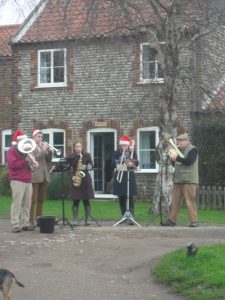 They were three generations of the same family raising money for Parkinsons Disease. The whole village turned out, there were hugs and kisses and Christmas greetings and children who’d decided to stay in the warm calling out of top-floor windows. It all felt very cosy and Miss Marple, hopefully without the murders! Another of my favourite screen depictions of a village is Bramley End in Cavalcanti’s thought-provoking 1942 film for Ealing Studios Went the Day Well. Based on Graham Greene’s short story The Lieutentant Died Last, this was a propaganda film designed to alert the country about the dangers of being complacent about the possibility of invasion. In the film, the villagers of Bramley End are far too trusting and are overrun by Nazi paratroopers posing as an English battalion. There’s a cast of much-loved 1940s actors – Leslie Banks, Thora Hird (in her first major role), Harry Fowler, Mervyn Johns, Valerie Taylor, Patricia Hayes, Basil Sydney… The village (actually the very pretty Turville in Buckinghamshire) is shown as an English rural idyll, depicting very successfully what we were fighting to preserve.
They were three generations of the same family raising money for Parkinsons Disease. The whole village turned out, there were hugs and kisses and Christmas greetings and children who’d decided to stay in the warm calling out of top-floor windows. It all felt very cosy and Miss Marple, hopefully without the murders! Another of my favourite screen depictions of a village is Bramley End in Cavalcanti’s thought-provoking 1942 film for Ealing Studios Went the Day Well. Based on Graham Greene’s short story The Lieutentant Died Last, this was a propaganda film designed to alert the country about the dangers of being complacent about the possibility of invasion. In the film, the villagers of Bramley End are far too trusting and are overrun by Nazi paratroopers posing as an English battalion. There’s a cast of much-loved 1940s actors – Leslie Banks, Thora Hird (in her first major role), Harry Fowler, Mervyn Johns, Valerie Taylor, Patricia Hayes, Basil Sydney… The village (actually the very pretty Turville in Buckinghamshire) is shown as an English rural idyll, depicting very successfully what we were fighting to preserve.





 I do, of course, spend quite a bit of time watching Christmas films. I’m sure we all enjoy creating our own traditions at Christmas and for us Christmas Day can’t start until we’ve watched It’s a Wonderful Life (1946) late on Christmas Eve. I always cry at the end, even after multiple viewings. James Stewart as George Bailey, in debt and trouble through no fault of his own, wants to die. Clarence, the angel who’s trying to get his wings, rescues him by showing him what life would be like if there were no George Bailey. It’s really a re-telling of Dickens’ A Christmas Carol, with Mr Potter as the evil banker – the bad side of Scrooge, and George Bailey as the benign banker who Scrooge later becomes. Clarence is all the ghosts of Christmas past, present and future wrapped into one as he shows George the impact he has had on everyone. The film has to be watched in conjunction with my favourite version of A Christmas Carol, the 1951 version with Alistair Sim as a fabulously histrionic Scrooge, although The Muppet Christmas Carol is a close second! Paddington, voiced by the inimitable Ben Whishaw, is fast becoming a Christmas favourite. I’ve been very interested in the discussions in the press discussing Paddington 2 and referencing Paddington as our outlet for Brexit frustration. He is the classic immigrant and the various attitudes of the community towards him reflect our somewhat divided nation at the moment.
I do, of course, spend quite a bit of time watching Christmas films. I’m sure we all enjoy creating our own traditions at Christmas and for us Christmas Day can’t start until we’ve watched It’s a Wonderful Life (1946) late on Christmas Eve. I always cry at the end, even after multiple viewings. James Stewart as George Bailey, in debt and trouble through no fault of his own, wants to die. Clarence, the angel who’s trying to get his wings, rescues him by showing him what life would be like if there were no George Bailey. It’s really a re-telling of Dickens’ A Christmas Carol, with Mr Potter as the evil banker – the bad side of Scrooge, and George Bailey as the benign banker who Scrooge later becomes. Clarence is all the ghosts of Christmas past, present and future wrapped into one as he shows George the impact he has had on everyone. The film has to be watched in conjunction with my favourite version of A Christmas Carol, the 1951 version with Alistair Sim as a fabulously histrionic Scrooge, although The Muppet Christmas Carol is a close second! Paddington, voiced by the inimitable Ben Whishaw, is fast becoming a Christmas favourite. I’ve been very interested in the discussions in the press discussing Paddington 2 and referencing Paddington as our outlet for Brexit frustration. He is the classic immigrant and the various attitudes of the community towards him reflect our somewhat divided nation at the moment.

 As you can see from the heading, I’ll be blogging under a new name from now on to celebrate our move from King’s Lynn to East Runton, a little village just outside Cromer near to where the late, great John Hurt lived. I’ve already started writing more sea related poetry than usual so it looks as if it could be an inspirational step in the right direction and there are lots of great cafes to explore locally!
As you can see from the heading, I’ll be blogging under a new name from now on to celebrate our move from King’s Lynn to East Runton, a little village just outside Cromer near to where the late, great John Hurt lived. I’ve already started writing more sea related poetry than usual so it looks as if it could be an inspirational step in the right direction and there are lots of great cafes to explore locally!
 I’m rather partial to modern cinematic adaptations of Jane Austen and Alicia Silverstone as a high-school Valley Girl version of Emma is one of my favourites, followed closely by Gurinder Chadha’s brilliantly cheesy Bollywood Bride and Prejudice. I often find myself, just as Emily Blunt’s character does in The Jane Austen Book Club, asking What Would Jane do?
I’m rather partial to modern cinematic adaptations of Jane Austen and Alicia Silverstone as a high-school Valley Girl version of Emma is one of my favourites, followed closely by Gurinder Chadha’s brilliantly cheesy Bollywood Bride and Prejudice. I often find myself, just as Emily Blunt’s character does in The Jane Austen Book Club, asking What Would Jane do?
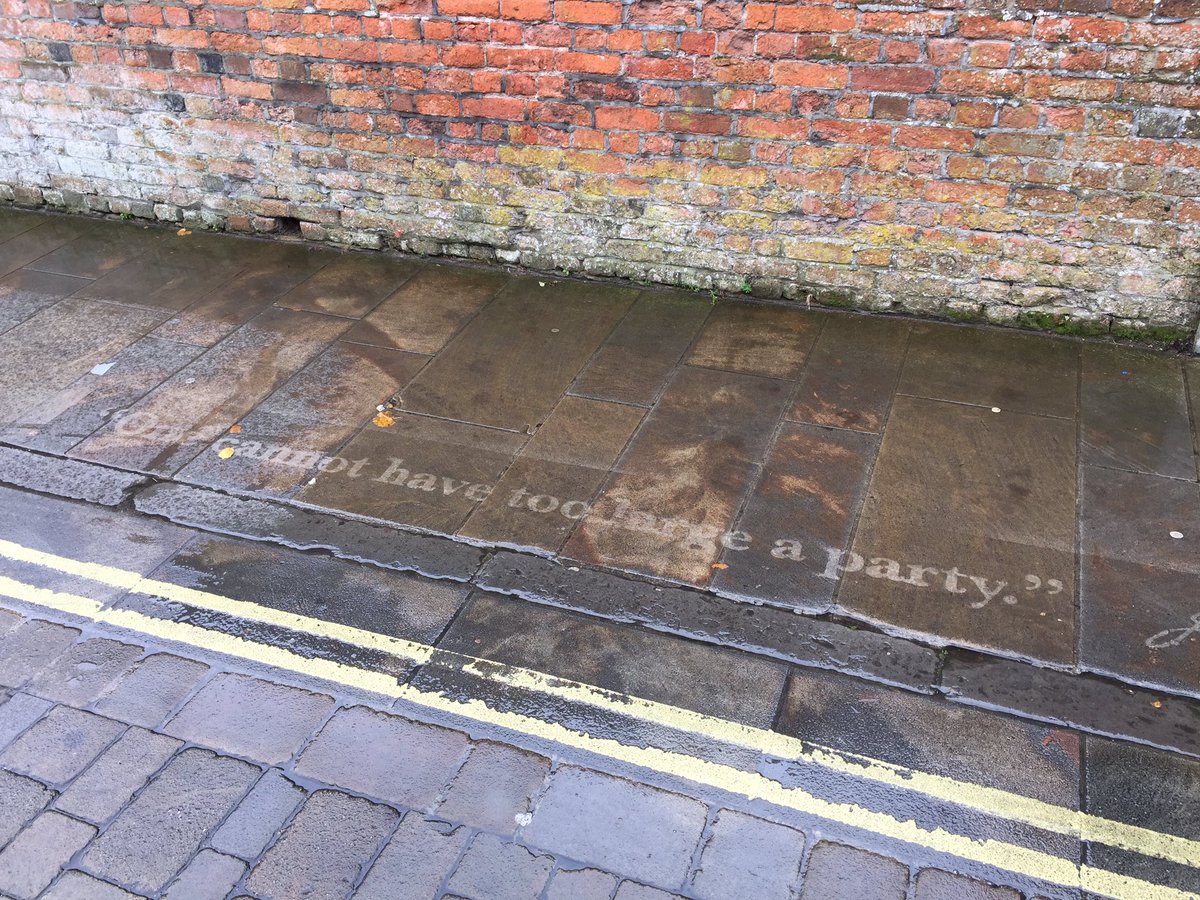 In May this year I visited Winchester, paid my respects at Jane’s gravestone in the cathedral and absorbed the atmosphere of this pretty town where she lived out her last few months. “I see more distinctly through the rain,” Jane once wrote and, with this in mind, there’s a wonderful trail through the town called Rain Jane. If it rains, quotes from her novels magically appear on the pavements and disappear as the rain evaporates.
In May this year I visited Winchester, paid my respects at Jane’s gravestone in the cathedral and absorbed the atmosphere of this pretty town where she lived out her last few months. “I see more distinctly through the rain,” Jane once wrote and, with this in mind, there’s a wonderful trail through the town called Rain Jane. If it rains, quotes from her novels magically appear on the pavements and disappear as the rain evaporates. I also visited the village of Chawton, where, in the cottage which is now the Jane Austen’s House Museum. Here, Jane, her mother and beloved sister Cassandra finally had a place they could call their own, albeit briefly. I stood reverently before the table where she wrote, trying not to be too angry at the tiny space she had to let her imagination run riot with the intricacies of hatching, matching and dispatching. This anger led to my only Austen inspired poem, the imaginatively titled Jane’s Table!
I also visited the village of Chawton, where, in the cottage which is now the Jane Austen’s House Museum. Here, Jane, her mother and beloved sister Cassandra finally had a place they could call their own, albeit briefly. I stood reverently before the table where she wrote, trying not to be too angry at the tiny space she had to let her imagination run riot with the intricacies of hatching, matching and dispatching. This anger led to my only Austen inspired poem, the imaginatively titled Jane’s Table!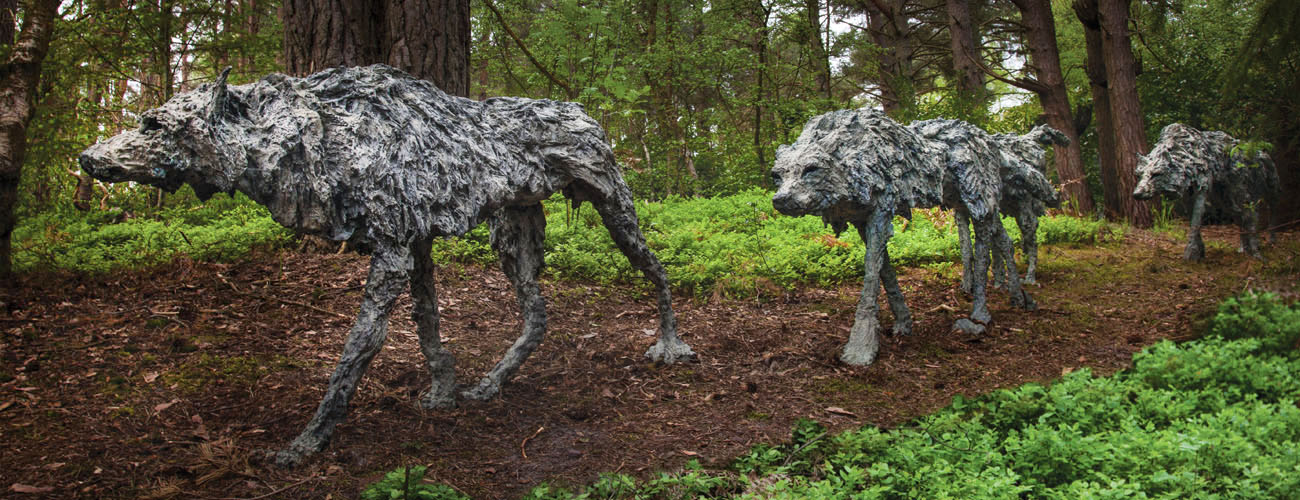 If you do find yourself in this part of Hampshire, then the Sculpture Park in Churt is well worth a visit. It’s really a giant open air exhibition showcasing around 800 pieces of work from approximately 300 different artists. This means it’s also well worth revisiting as the pieces are all for sale and change constantly. It’s set in ten acres of woodland and heathland with some quite steep parts at times as it’s set in a natural valley. There are three lakes fed by natural springs which provide a stunning backdrop for some of the artwork.
If you do find yourself in this part of Hampshire, then the Sculpture Park in Churt is well worth a visit. It’s really a giant open air exhibition showcasing around 800 pieces of work from approximately 300 different artists. This means it’s also well worth revisiting as the pieces are all for sale and change constantly. It’s set in ten acres of woodland and heathland with some quite steep parts at times as it’s set in a natural valley. There are three lakes fed by natural springs which provide a stunning backdrop for some of the artwork. So, this month we’ve been listening to I, Gemini. Definitely the sound of summer, this is the debut album of Let’s Eat Grandma, Norwich-based teenage duo Rosa Walton and Jenny Hollingworth, both are multi-instrumentalists as well as singer-songwriters. The album is getting great reviews, it’s trancey, psychedelic pop, deeply weird and wonderful… I’ve known Rosa since she was born as I’m a good pal of mum Adrienne and was delighted to discover that the band were playing twice while I was in Paris. The first gig was at Point Ephémère, a trendy warehouse venue by Canal St Martin and the girls were playing as part of Rough Trade’s Pop-up Store on Record Store Day (Jour Disquaire). Their second gig was at Les Trois Baudets in the Pigalle area, just up the road from the Museum of Erotica. Adrienne and I went for coffee and cake at the Amelie café (Café des Deux Moulins) and then joined the girls, Lee, their technician and Philippe, the record label’s local rep, for dinner in the great café above the venue. Let’s Eat Grandma played their brilliant brand of pixie pop to an appreciative and enthusiastic audience and I helped out for a few minutes on the merch stall afterwards which was dead exciting
So, this month we’ve been listening to I, Gemini. Definitely the sound of summer, this is the debut album of Let’s Eat Grandma, Norwich-based teenage duo Rosa Walton and Jenny Hollingworth, both are multi-instrumentalists as well as singer-songwriters. The album is getting great reviews, it’s trancey, psychedelic pop, deeply weird and wonderful… I’ve known Rosa since she was born as I’m a good pal of mum Adrienne and was delighted to discover that the band were playing twice while I was in Paris. The first gig was at Point Ephémère, a trendy warehouse venue by Canal St Martin and the girls were playing as part of Rough Trade’s Pop-up Store on Record Store Day (Jour Disquaire). Their second gig was at Les Trois Baudets in the Pigalle area, just up the road from the Museum of Erotica. Adrienne and I went for coffee and cake at the Amelie café (Café des Deux Moulins) and then joined the girls, Lee, their technician and Philippe, the record label’s local rep, for dinner in the great café above the venue. Let’s Eat Grandma played their brilliant brand of pixie pop to an appreciative and enthusiastic audience and I helped out for a few minutes on the merch stall afterwards which was dead exciting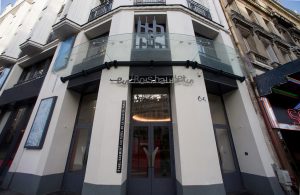 !
!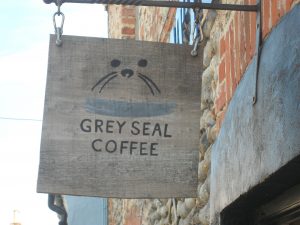 Walking and writing are such complementary activities. The rhythm of walking very much mirrors the rhythms of poetry and I often walk stuck ideas out into the open. I rarely want to write in the style of a flaneur when I’m out in the countryside, it’s very much an urban style after all, a bit like Frank O’Hara’s brilliant lunch poems – you need a busy scene with lots of people and activity and a slightly grungy feel to the whole scenario. When out and about in the great outdoors haiku are the perfect fit – I seem to compose them endlessly the minute I get a whiff of fresh air. This Japanese poetic style is much loved by Westerners. Short, delicate, just three lines and 17 syllables in total (although balance is more important than syllabic perfection), haiku are a great way to record impressions and their focus is usually the natural world and the seasons. The great Japanese haiku master was Matsuo Basho (1644-94), one of my favourites by Basho is:
Walking and writing are such complementary activities. The rhythm of walking very much mirrors the rhythms of poetry and I often walk stuck ideas out into the open. I rarely want to write in the style of a flaneur when I’m out in the countryside, it’s very much an urban style after all, a bit like Frank O’Hara’s brilliant lunch poems – you need a busy scene with lots of people and activity and a slightly grungy feel to the whole scenario. When out and about in the great outdoors haiku are the perfect fit – I seem to compose them endlessly the minute I get a whiff of fresh air. This Japanese poetic style is much loved by Westerners. Short, delicate, just three lines and 17 syllables in total (although balance is more important than syllabic perfection), haiku are a great way to record impressions and their focus is usually the natural world and the seasons. The great Japanese haiku master was Matsuo Basho (1644-94), one of my favourites by Basho is: One of the first feature films to be shot in Norfolk was The Rolling Road in 1927 starring Flora le Breton. Legend has it that the October sea at Great Yarmouth proved too much for the skimpily-clad heroine and she had to be saved by Carlyle Blackwell, her co-star, although some say she was saved not by the film’s hero but by Robert “Chickie” Drane, a Yarmouthian who was an acknowledged champion swimmer and lifesaver and allegedly doubled for Carlyle Blackwell in the aquatic scenes.
One of the first feature films to be shot in Norfolk was The Rolling Road in 1927 starring Flora le Breton. Legend has it that the October sea at Great Yarmouth proved too much for the skimpily-clad heroine and she had to be saved by Carlyle Blackwell, her co-star, although some say she was saved not by the film’s hero but by Robert “Chickie” Drane, a Yarmouthian who was an acknowledged champion swimmer and lifesaver and allegedly doubled for Carlyle Blackwell in the aquatic scenes.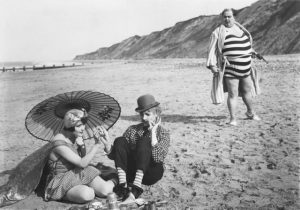 Another notable early film shot partly in Norfolk was Anthony Asquith’s 1928 Shooting Stars. Chili Bouchier won a competition in the Daily Mail to become a film star and here she is as a bathing belle on Cromer beach. One of our classic British films, The Go Between, starring Julie Christie and Alan Bates, was shot in Norfolk using locations at Thornage, Hickling Broad, Holkham, Heydon, Norwich, Melton Constable and Hanworth to evoke the hottest day of the year in 1900. Norfolk is so held in time that I often feel I am walking in the past evoked by these films, until my next stop for an expresso shot at the defiantly 21st century Grey Seal, that is!
Another notable early film shot partly in Norfolk was Anthony Asquith’s 1928 Shooting Stars. Chili Bouchier won a competition in the Daily Mail to become a film star and here she is as a bathing belle on Cromer beach. One of our classic British films, The Go Between, starring Julie Christie and Alan Bates, was shot in Norfolk using locations at Thornage, Hickling Broad, Holkham, Heydon, Norwich, Melton Constable and Hanworth to evoke the hottest day of the year in 1900. Norfolk is so held in time that I often feel I am walking in the past evoked by these films, until my next stop for an expresso shot at the defiantly 21st century Grey Seal, that is!